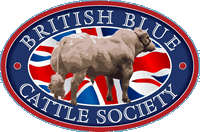40 Years of Feed Efficiency Data From 6000 Pedigree Blue Bulls
With A Feed Efficiency improvement up to 1Kg/Kg by using a Blue
16th May 2014
One of the firsts for ‘Blue’ genetics is that they have been recorded for ‘Feed Efficiency’, in Belgium, for over 40 years!
The genetic pool of the Belgian and British Herd Books have been very closely integrated over the last 30 years, hence this genetic pool being referred to as the ‘Blues’, for convenience, in this article. Using a quality ‘Blue’ can improve Feed Efficiency by up to 1Kg/Kg!! Recording Facilities There are two trial centres in Belgium, operated by the “Centre de Sélection Bovine” at two sites one at Ciney which became operational in 1973, with a capacity for 320 bulls per year (80 pens, 4 bulls per pen) and the other at Ath, operating from 1995, with a capacity for 200 bulls, per year (10 pens, 5 bulls per pen).Selection of Breeding Stock for Performance Tests
From 1985, the Ciney station and from the beginning, the Ath station were entirely dedicated to the individual performance testing of Pedigree breeding bulls. Individual feed intake was recorded between 7 and 13 months using the Calan system in Ciney up to 2007 and thereafter with an automatic tube feeder as in Ath
At the end of the test period, a panel of breeders appointed by the Belgian Herd Book ranked the bulls into 3 categories: 1) Admitted for sale by public auction at Ciney, 2) Returned to the herd of origin, 3) Culled.
Growth and FCR results from Registered Bulls being:-
Total number of Pedigree Bulls recorded 6,000
Trial Period 7 – 13 months
Initial weight 260kg ± 30
Final Weight 546kg ± 50.4
Average Daily Gain 1.47 ± 0.19
FC kg/kg 5.63 ± 0.66
Some well-known sires, famous in the breed, ‘Galopeur des Hayons’ having a recorded FCR as low 5.24 kg/kg and ‘Riant’ with a figure of 5.36 kg/kg
The Favourable effect of the Double Muscling Gene, progeny test data In addition four, early, studies analysed progeny test data, recorded in the Ciney station and confirmed the beneficial effect on Feed Conversion Ratio and Average Daily Gain by using the ‘Blue’.First Study
The first study pointed out the improvement in the Feed Conversion Ratio (FCR) between Double-Muscled ‘Blue’ bulls (no. 54) compared to the original Dual Purpose ‘Blue’ (no.64) and showed an improvement from 6.32 to 5.85 kg concentrates / kg gain.
An improvement of nearly half a kilo or 7.5% in FCR.
Animal being taken from 7 and 12 months of age on a diet consisting of concentrates (2.8 Mcal ME / kg DM and 14% digestible crude protein) and straw both ad libitum. The feed intake of each animal was provided by an individual feeder with electronic access (Calan system). The advantage of Double Muscled bulls could be explained by their higher rate of protein gain.Second Study
The second one compared Double-Muscled bulls (no. 622) with Dual Purpose ‘Blue’ bulls (No. 236), crossbred Double-Muscled ‘Blue’ x Friesians (n=94) and Double-Muscled ‘Blue’ x Meuse-Rhine-Issel (MRI) (No. 20) in the same experimental conditions. The observed feed conversion ratios were 5.85, 6.41, 6.66 and 6.67 kg concentrates / kg gain respectively.
Demonstrating up to 12% improvement in FCR with the Double Muscled ‘Blue’ genetics, over the other groups.Third Study
The third one compared dairy Friesian and Meuse-Rhine-Issel bulls, to crossbred ‘Blue’ x Friesian and Meuse-Rhine-Issel bulls.
Friesian FCR 6.54
BB X Friesian FCR 6.21
Meuse-Rhine-Yssel FCR 6.54
BB X Meuse-Rhine-Issel FCR 6.31
Showing an improved finishing performance in animals carrying ‘Blue’genetics with a 3.5% to 5% improvement in FCR.Fourth Study
The fourth one was conducted on Friesian bulls and crossbred x Friesian bulls fed on concentrates and maize silage ad libitum (2.6 Mcal/kg DM), complemented with dried sugar beep pulp and soya bean meal, in two other university stations, Gembloux and Liege.
This trial, involving 66 animals, showed an average FCR and Average Daily Gain of improvement of just over 7% each.
Conclusions
Feed Conversion Ratio is moderately heritable and depends, in a given period, on the initial age and weight and increases along this period. More specifically in the ‘Blue’ the Double-Muscling influence within the breed’s genetics, improves Average Daily Gain and the Feed Efficiency Ratio and this is carried over into ‘Blue’ crossbreds, improving growth performance and carcase and meat quality. Overall breed Feed Conversion Ratio figures of 6.8 -7 Kg/Kg, being the norm.
Results also indicating that by using ‘Blue’ genetics an approximate 7% improvement in feed efficiency and growth can be expected from ‘Blue’ X commercial offspring!
John Fleming, Secretary of the British ‘Blues’ commented:-
‘Trials over many decades have proven the Feed Efficiency and Growth benefits of using ‘Blue’ genetics, which is constantly boosting margins of both Dairy and Suckler beef producers using ‘Blue’ sires, throughout the length and breadth of the UK.’
The Future
Since 2005, the goal of the Ath station is to provide phenotypic data to constitute a reference population required to develop the genomic selection in ‘Blue’ genetics.




Bulls on trial
John Fleming
Secretary
British Blue Cattle Society.
6nd May 2014
With grateful acknowledgment to Charles Michaux, University of Liège and Pierre Mallieu, Herd – Book Blanc Bleu Belge.

